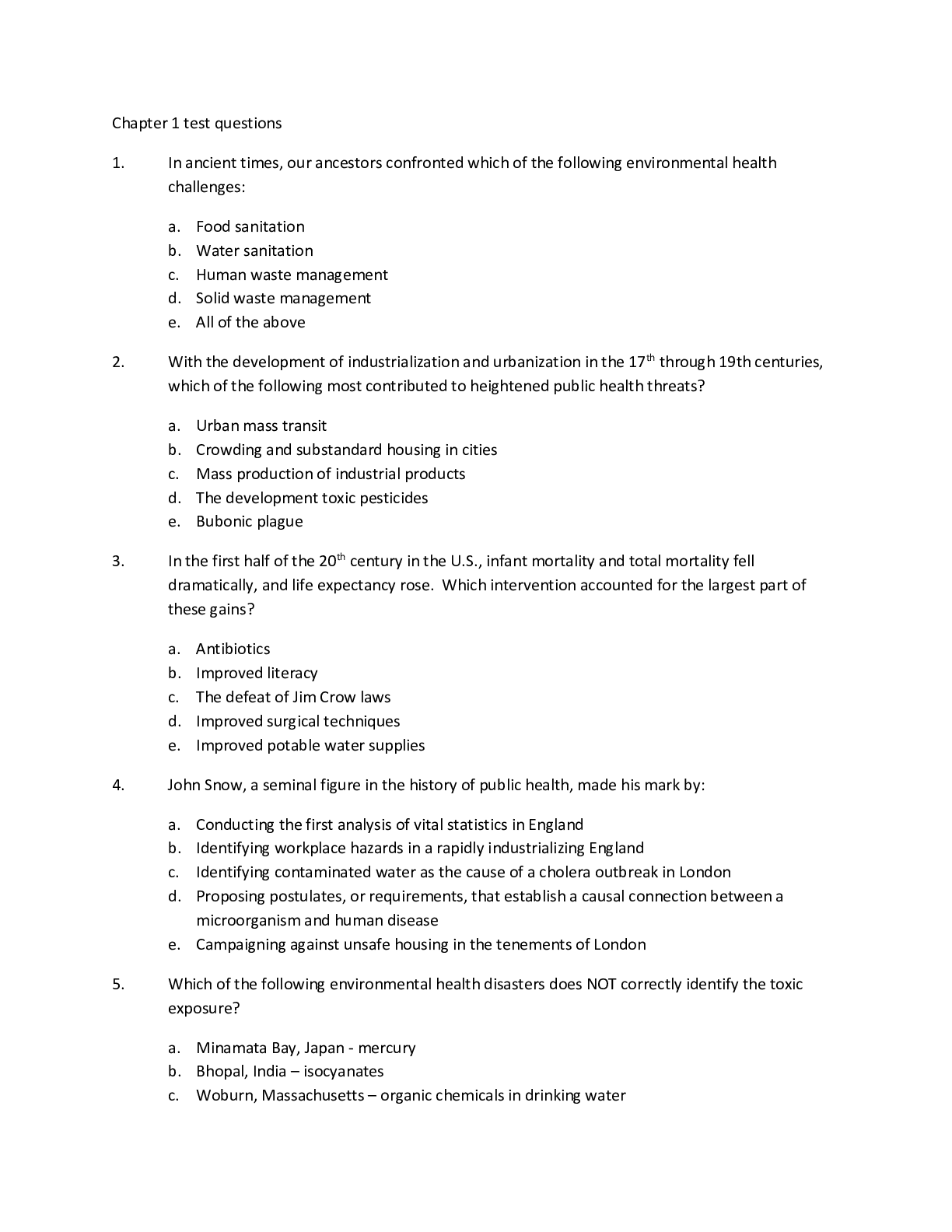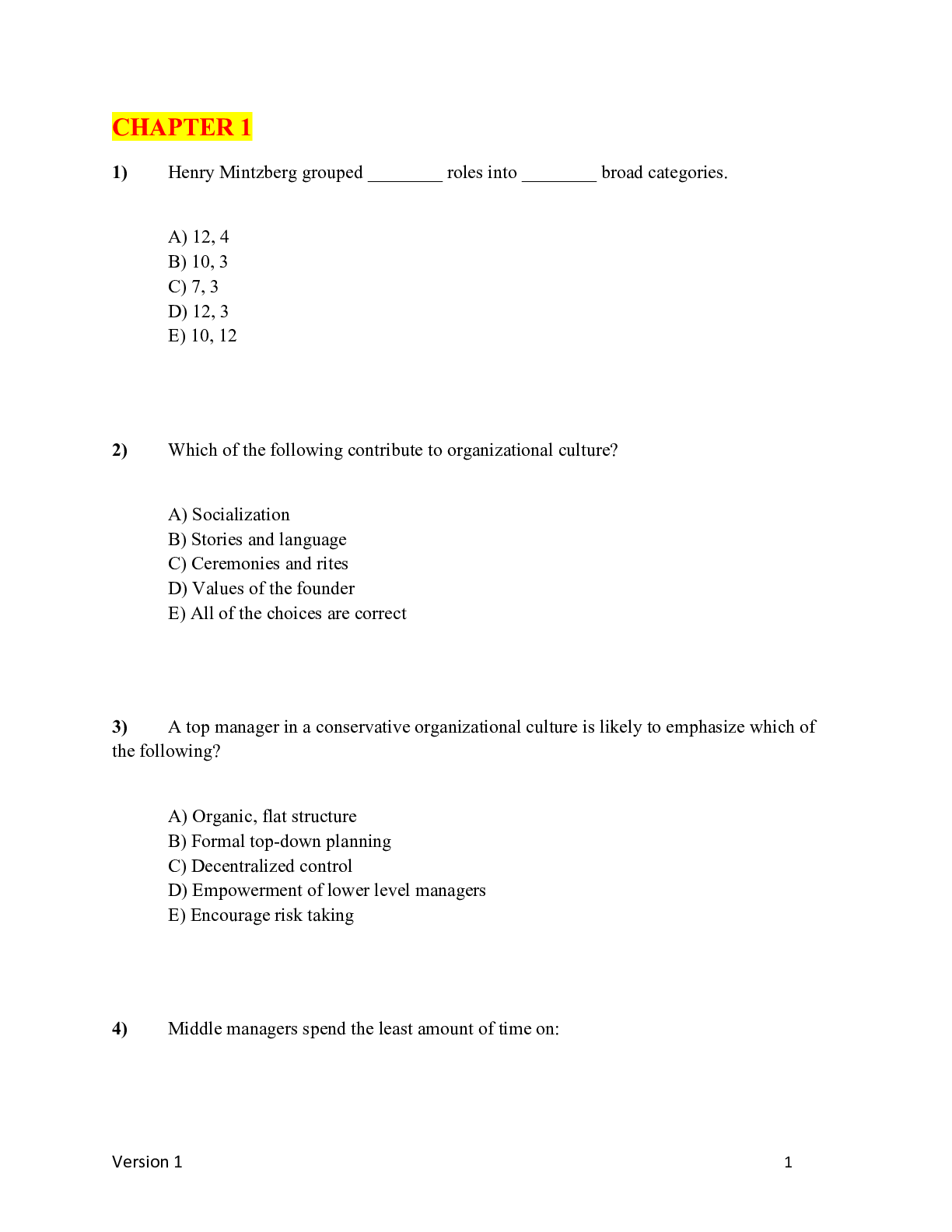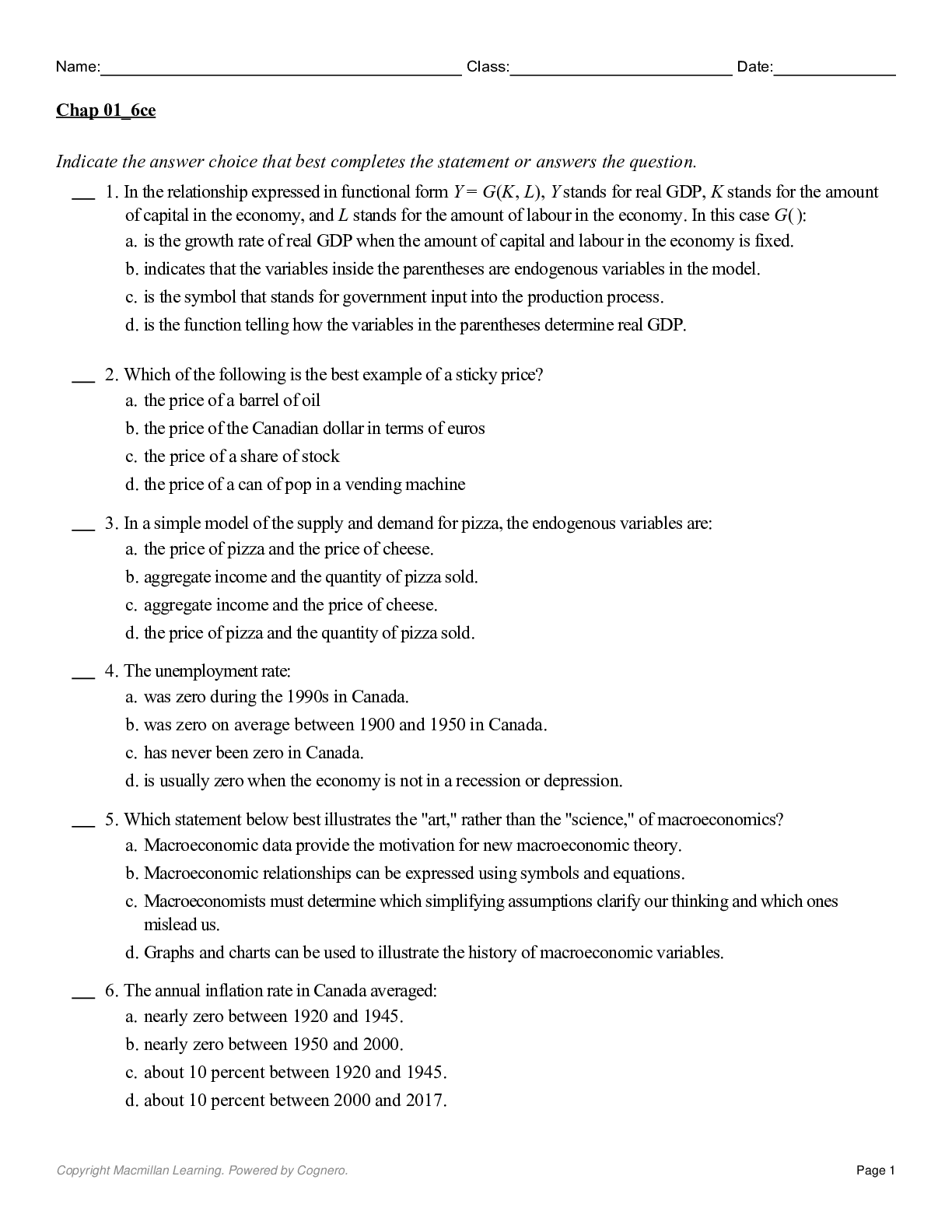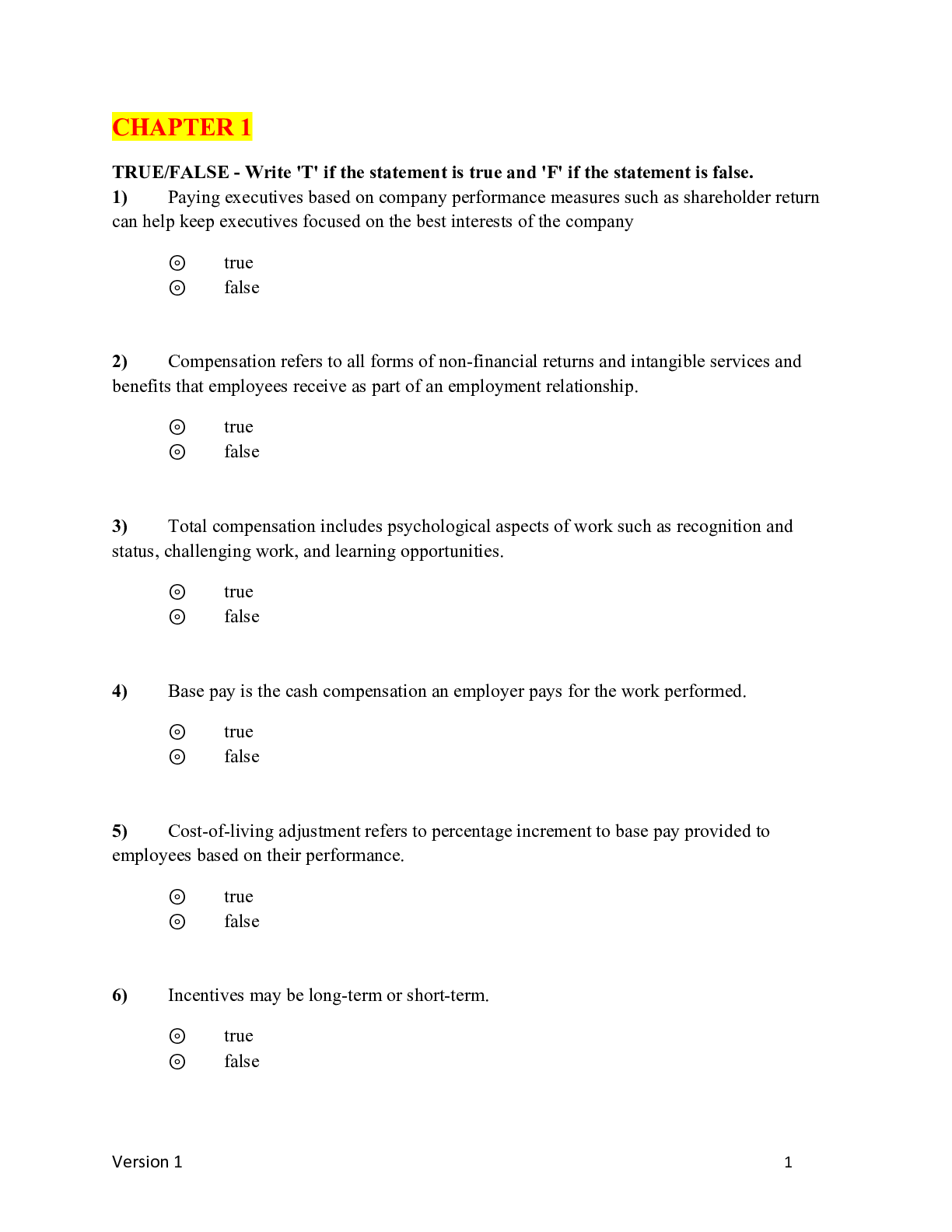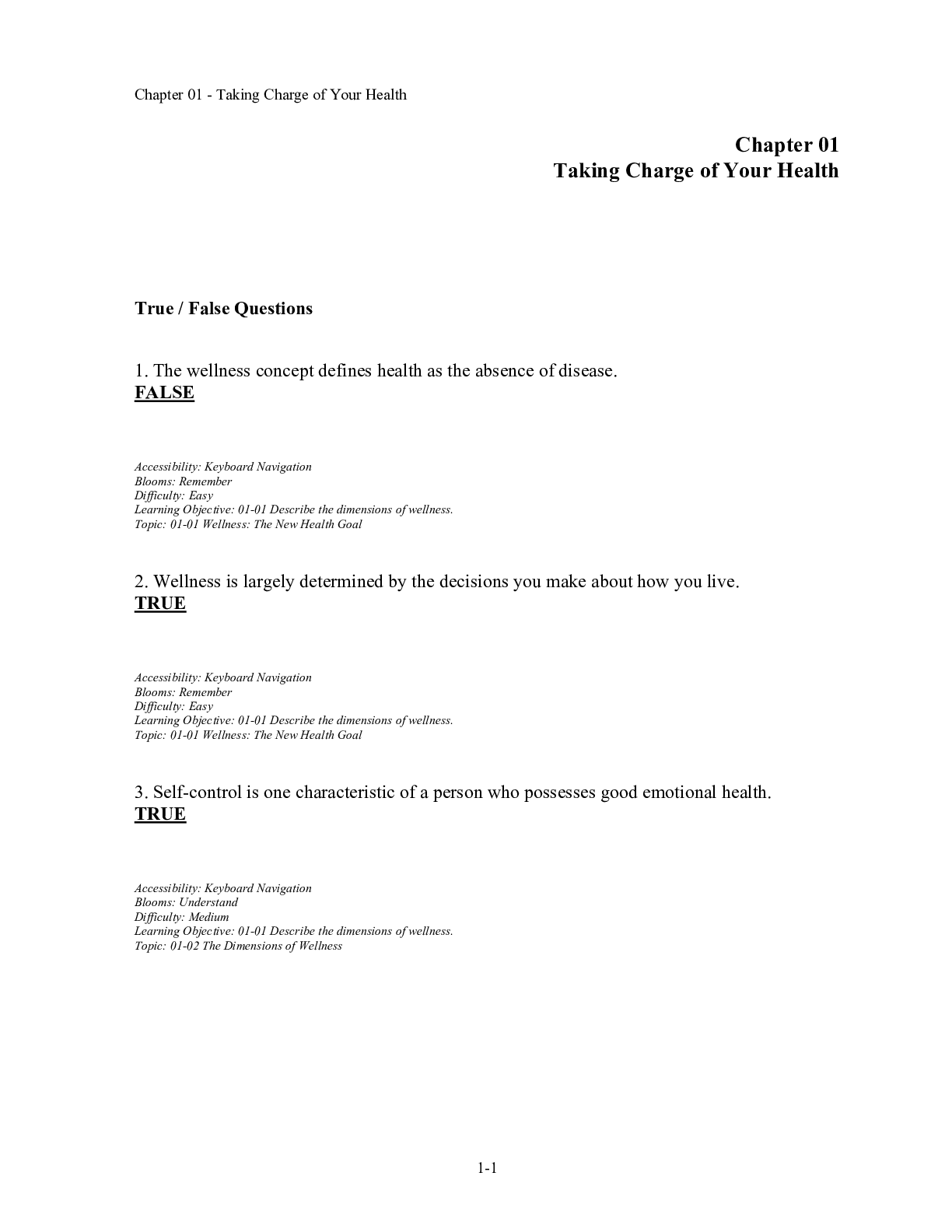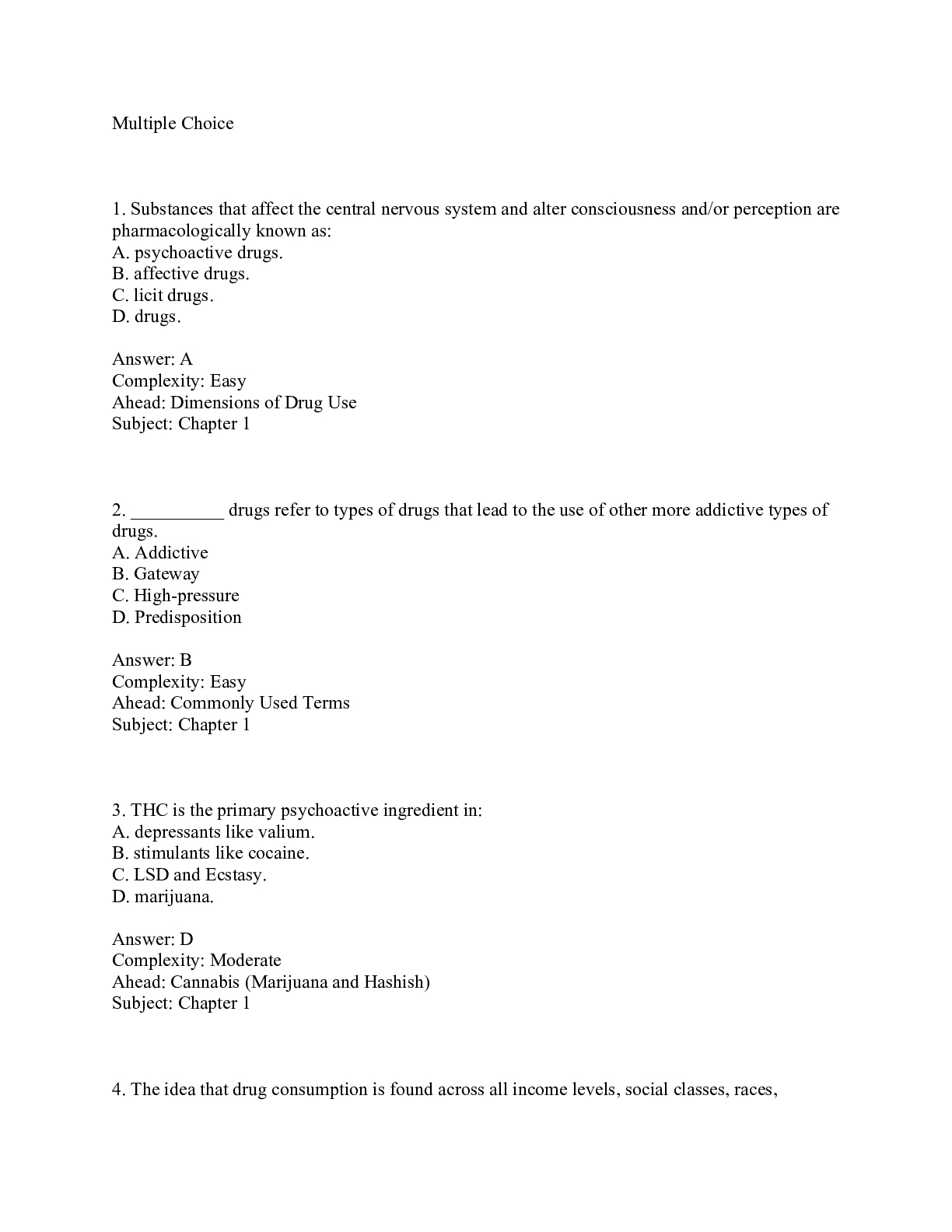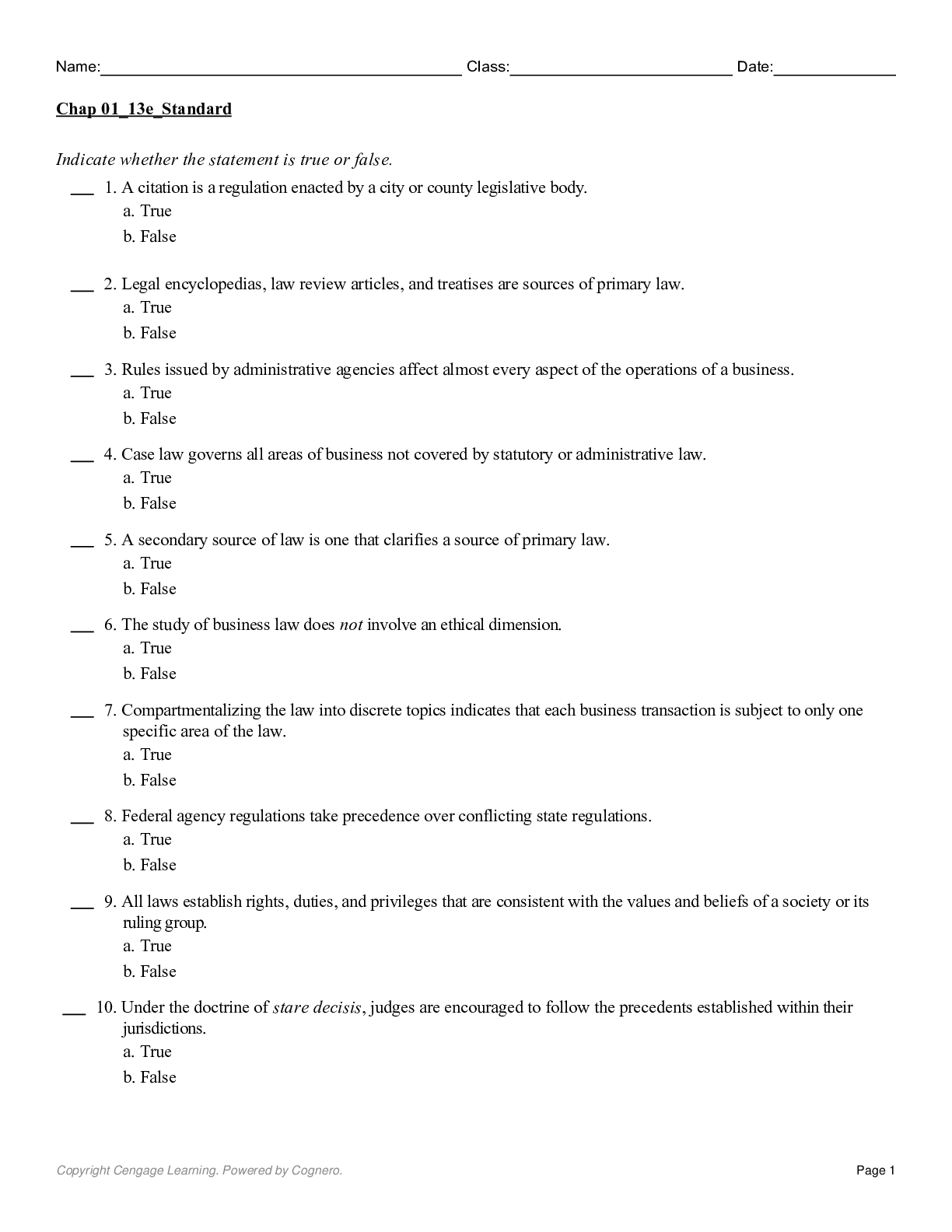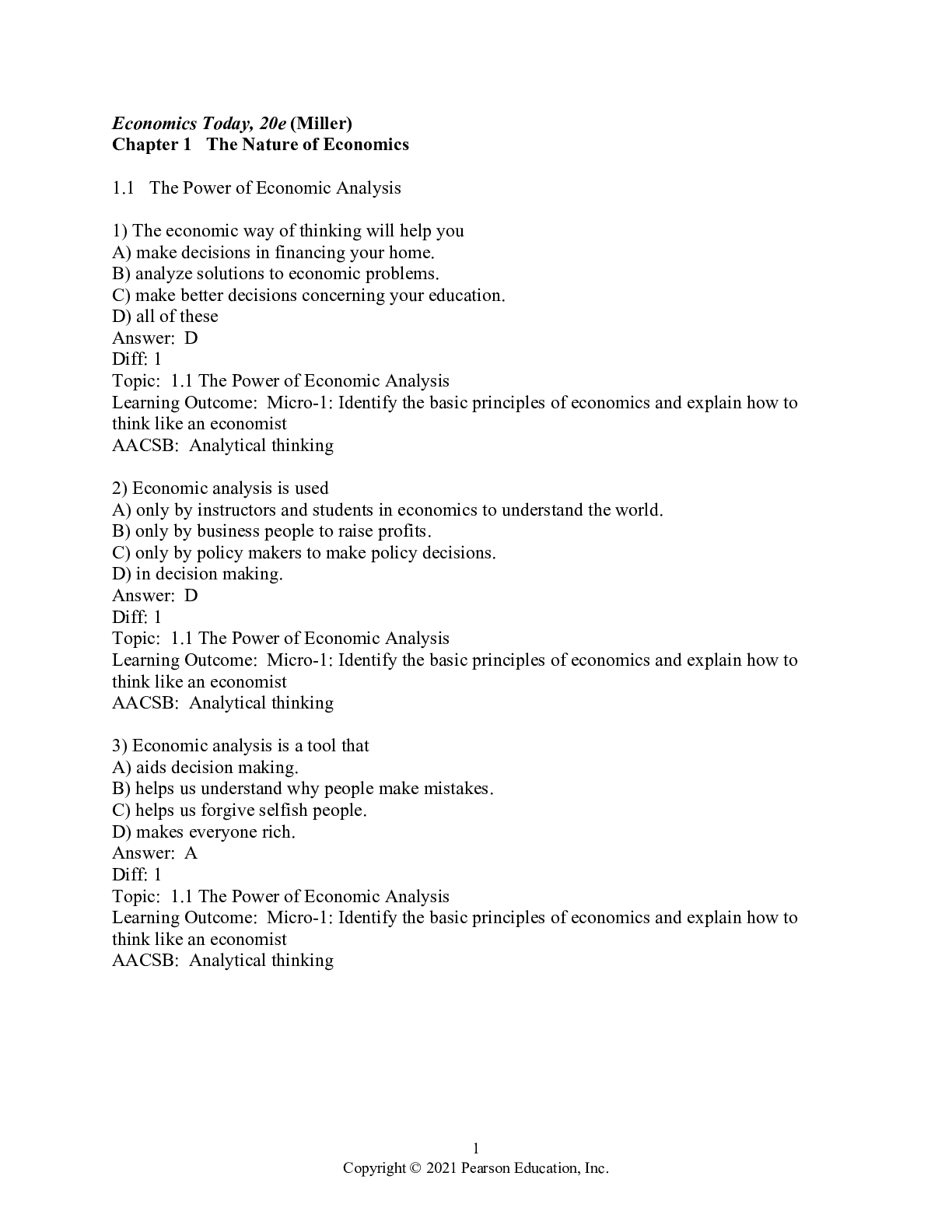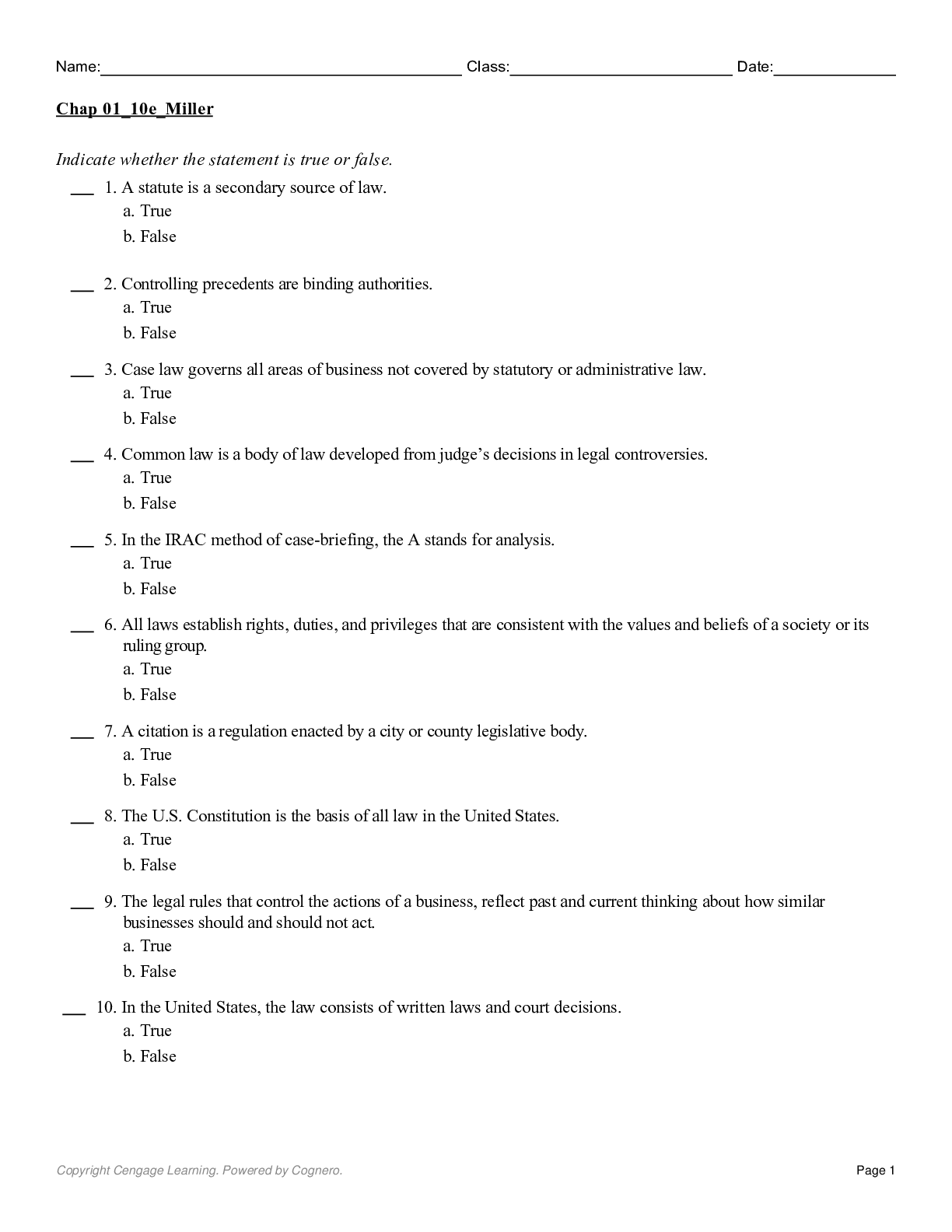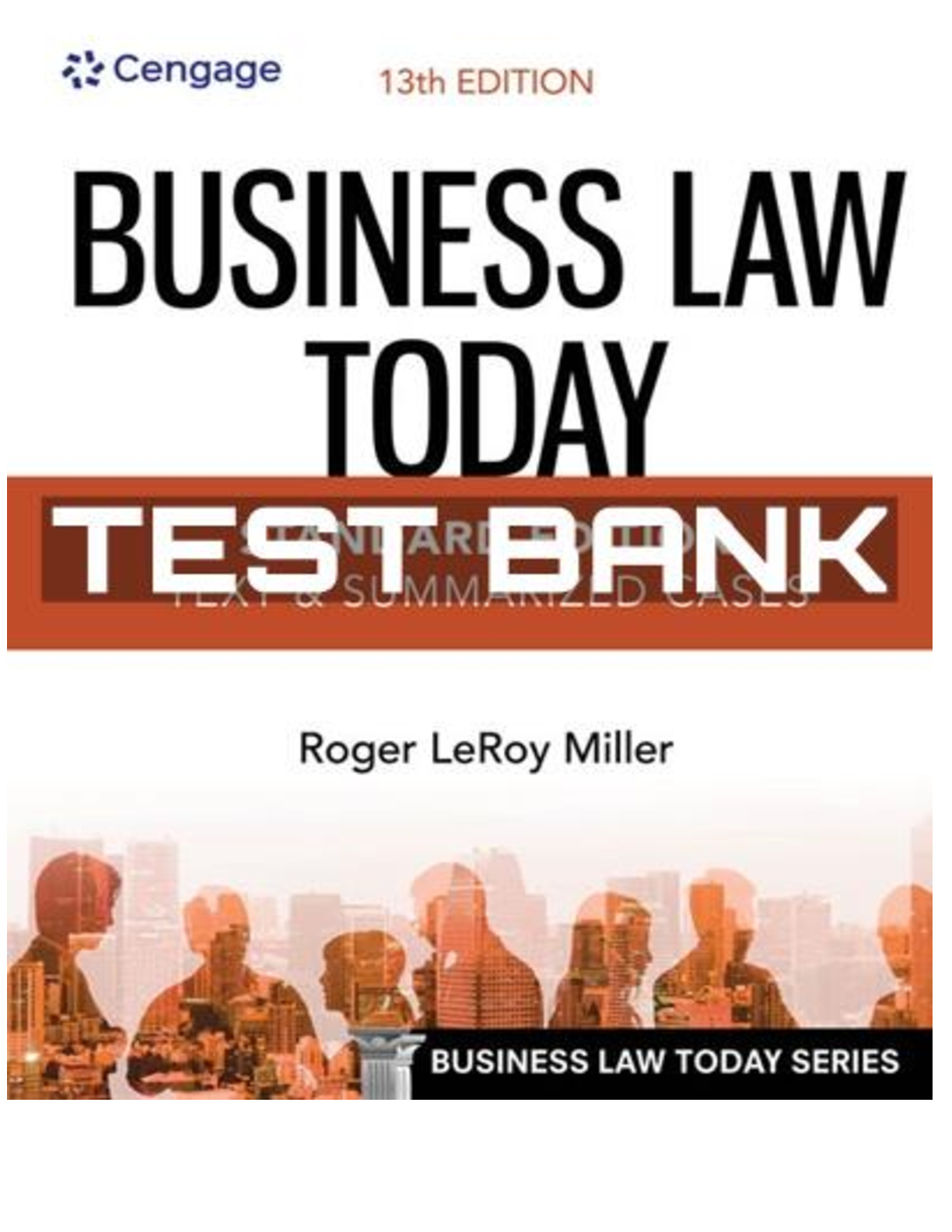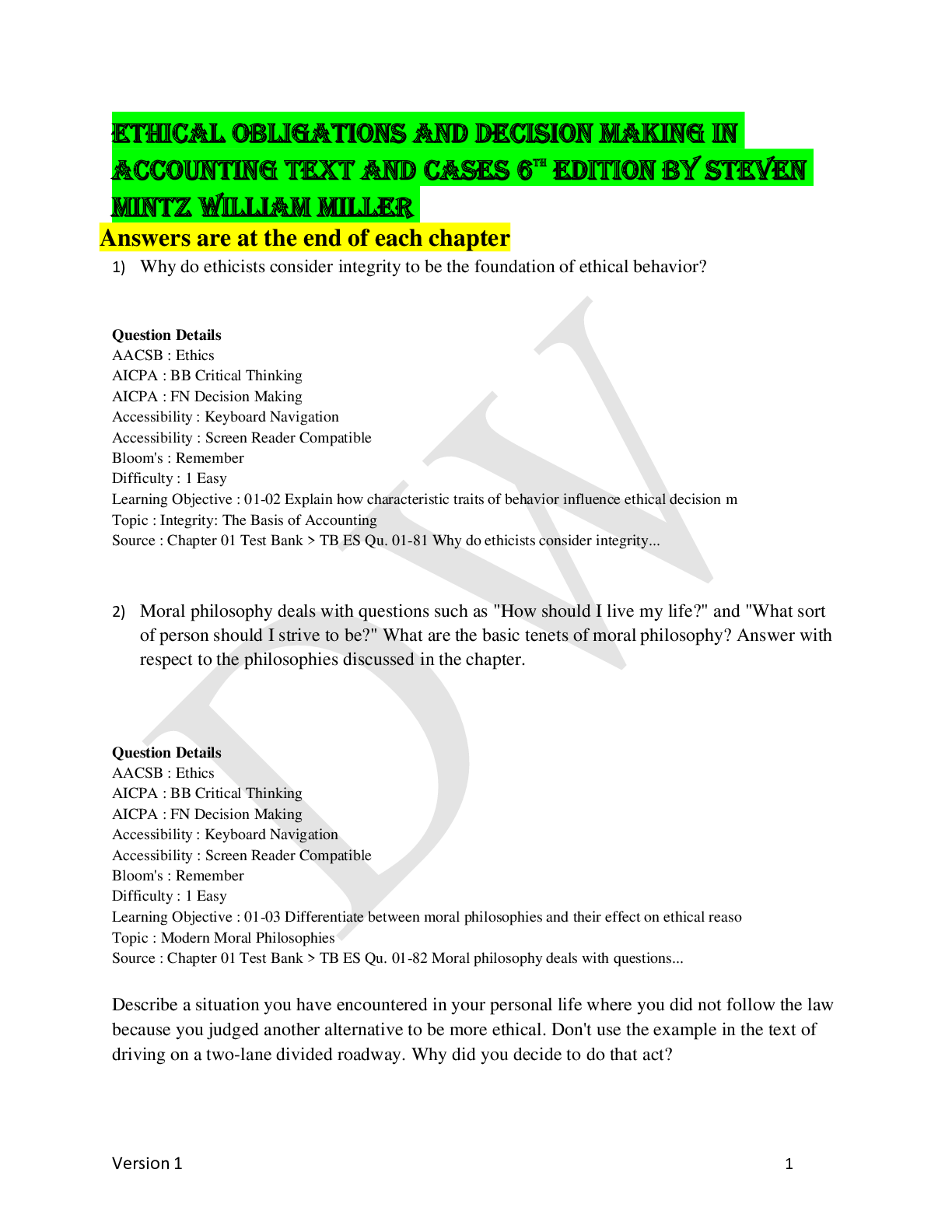Economics Today The Macro View, 20Tth Edition by Miller TEST BANK
Document Content and Description Below
Test Bank for Economics Today The Macro View, 20th Edition, 20e by Roger LeRoy Miller TEST BANK ISBN-13: 9780136715665 Full chapters included Part 1 Introduction 1 The Nature of Economics Learn... ing Objectives The Power of Economic Analysis Defining Economics Microeconomics versus Macroeconomics The Three Basic Economic Questions and Two Opposing Sets of Answers The Three Basic Questions Two Opposing Sets of Answers Centralized Command and Control The Price System Mixed Economic Systems The Economic Approach: Systematic Decisions The Rationality Assumption Responding to Incentives Defining Self-Interest Economics as a Science Models and Realism Assumptions The Ceteris Paribus Assumption: All Other Things Being Equal Deciding on the Usefulness of a Model Models of Behavior, Not Thought Processes Behavioral Economics and Bounded Rationality Bounded Rationality Rules of Thumb Behavioral Economics Goes Mainstream Positive versus Normative Economics Distinguishing between Positive and Normative Economics A Warning: Recognize Normative Analysis The Choice Faced by a Woman Considering Marriage to a Man Working or Seeking Work in Manufacturing Male Employment and Earnings Losses in Manufacturing and a Decrease in the Number of Married Women For Critical Thinking Real Application What You Should Know Problems References Appendix A Reading and Working with Graphs Direct and Inverse Relationships Constructing a Graph A Number Line Combining Vertical and Horizontal Number Lines Graphing Numbers in a Table The Slope of a Line (A Linear Curve) Slopes of Linear (Straight-Line) Curves Slopes of Nonlinear Curves Slope Varies along a Nonlinear Curve Measuring Slope at a Point along a Nonlinear Curve What You Should Know Problems 2 Scarcity and the World of Trade-Offs Learning Objectives Scarcity What Scarcity Is Not Scarcity and Resources Goods versus Economic Goods Wants and Needs Opportunity Cost, Trade-Offs, and Choices Valuing Forgone Alternatives Opportunity Cost The World of Trade-Offs and Your Future Expected Income Graphical Analysis The Production Possibilities Curve (PPC) Production Possibilities for Course Grades Measuring Trade-Offs Along a Production Possibilities Curve The Economic Choices a Nation’s People Face A Two-Good Example Production Trade-Offs Assumptions Underlying the Production Possibilities Curve Being off the Production Possibilities Curve Efficiency The Law of Increasing Additional Cost Increasing Additional Costs Explaining the Law of Increasing Additional Cost Economic Growth, Production Possibilities, and the Trade-Off between Present and Future Economic Growth and the Production Possibilities Curve The Trade-Off between the Present and the Future Why We Make Capital Goods Forgoing Current Consumption The Trade-Off between Consumption Goods and Capital Goods Comparative Advantage and Maximizing Your Future Income Comparative Advantage Absolute Advantage Absolute Advantage versus Comparative Advantage Comparative Advantage in Sports Scarcity, Self-Interest, and Specialization The Division of Labor Comparative Advantage and Trade among Nations Trade among Regions International Aspects of Trade The Parking Space Requirements—and the Implied Trade-Offs Opportunity Cost and the Allocation of Land to Parking Spaces For Critical Thinking Real Application What You Should Know Problems References 3 Demand and Supply Learning Objectives Demand The Law of Demand Relative versus Money Prices and Your Future Consumer Choices The Relative Price of Houses and Cars Comparing Relative Prices of Digital Storage Drives The Demand Schedule The Demand Curve Individual versus Market Demand Curves Shifts in Demand The Other Determinants of Demand Income Tastes and Preferences Prices of Related Goods: Substitutes and Complements Expectations Market Size (Number of Potential Buyers) Changes in Demand versus Changes in Quantity Demanded Supply The Law of Supply The Supply Schedule The Supply Curve The Market Supply Curve Shifts in Supply The Other Determinants of Supply Technology and Productivity Prices of Inputs Used to Produce the Product Price Expectations Taxes and Subsidies Number of Firms in the Industry Changes in Supply versus Changes in Quantity Supplied Putting Demand and Supply Together Demand and Supply Schedules Combined Equilibrium Shortages Surpluses Falling Soft Drink Consumption and Rising Bottled-Water Consumption: The Usual Media Interpretation A Missing Element: A Decline in the Price of Bottled Water Relative to the Price of Soft Drinks For Critical Thinking Real Application What You Should Know Problems References 4 Extensions of Demand and Supply Analysis Learning Objectives The Price System and Markets Exchange and Markets Transaction Costs The Role of Middlemen Changes in Demand and Supply Effects of Changes in Either Demand or Supply Situations in Which Both Demand and Supply Shift Changes of Demand and Supply in the Same Direction Changes of Demand and Supply in Opposite Directions Price Flexibility and Adjustment Speed The Rationing Function of Prices The Essential Role of Rationing Price Ceilings Price Ceilings and Black Markets Nonprice Rationing Devices Black Markets The Policy of Rent Ceilings The Functions of Rental Prices Rent Controls and Construction Effects on the Existing Supply of Housing Rationing the Current Use of Housing Attempts to Evade Rent Ceilings Who Loses and Who Gains from Rent Ceilings? Why Both Landlords and Some Tenants Lose Beneficiaries of Rent Controls Price Floors and Quantity Restrictions Price Floors and Price Supports in Agriculture Implementing Agricultural Price Support An Effective Agricultural Price Floor Who Benefits from Agricultural Price Supports? Keeping Price Supports Alive under a New Name The Main Beneficiaries of Agricultural Subsidies Price Floors in the Labor Market Minimum Wages in the United States Economic Effects of a Minimum Wage Explaining the Overall Decrease in Employment Your Summer Plans if the Minimum Wage Were, Say, $25 an Hour Quantity Restrictions Explaining Most Pharmaceuticals Shortages Upward Pressures on Prices of Replacement Drugs For Critical Thinking Real Application What You Should Know Problems References Appendix B Consumer Surplus, Producer Surplus, and Gains from Trade within a Price System Consumer Surplus Willingness to Pay Graphing Consumer Surplus Producer Surplus Willingness to Sell Graphing Producer Surplus Gains from Trade within a Price System Price Controls and Gains from Trade 5 Public Spending and Public Choice Learning Objectives Market Failures and Externalities Advantages of a Price System Consumer Sovereignty Benefits of Competition among Sellers and Buyers Market Failures and Externalities Externalities External Costs in Graphical Form External Benefits in Graphical Form Resource Misallocations of Externalities How the Government Can Correct Negative Externalities Special Taxes Regulation How the Government Can Correct Positive Externalities Government Financing and Production Regulation Subsidies The Other Economic Functions of Government Providing a Legal System Promoting Competition Providing Public Goods Private Goods and Rival Consumption Public Goods Characteristics of Public Goods Free Riders Ensuring Economywide Stability The Political Functions of Government Government-Sponsored and Government-Inhibited Goods Income Redistribution Public Spending and Transfer Programs Publicly Subsidized Health Care: Medicare The Simple Economics of Medicare Medicare Incentives at Work Health Care Subsidies Continue to Grow Economic Issues of Public Education The Now-Familiar Economics of Public Education The Incentive Problems of Public Education Decision Making as a Parent Collective Decision Making: The Theory of Public Choice Similarities in Market and Public-Sector Decision Making Opportunity Cost Competition Similarity of Individuals Differences between Market and Collective Decision Making Government Goods and Services at Zero Price Use of Force Voting versus Spending Why the Services Provided by State Parks Are Not Public Goods How Wisconsin State Parks’ Ties to Government Are Fraying For Critical Thinking Real Application What You Should Know Problems References 6 Funding the Public Sector Learning Objectives Paying for the Public Sector: Systems of Taxation The Government Budget Constraint Implementing Taxation with Tax Rates The Tax Base and the Tax Rate Marginal and Average Tax Rate Taxation Systems Proportional Taxation Progressive Taxation Regressive Taxation The Most Important Federal Taxes The Federal Personal Income Tax The Treatment of Capital Gains The Corporate Income Tax Making Decisions to Maximize Your Future Income Double Taxation Who Really Pays the Corporate Income Tax? Social Security and Unemployment Taxes Social Security Taxes Unemployment Insurance Taxes Tax Rates and Tax Revenues Sales Taxes Static Tax Analysis Dynamic Tax Analysis Maximizing Tax Revenues Taxation from the Point of View of Producers and Consumers Taxes and the Market Supply Curve How Taxes Affect the Market Price and Equilibrium Quantity Who Pays the Tax? Alternatives for Maintaining Current Social Security Benefits Alternatives for Reducing Total Social Security Payouts For Critical Thinking Real Application What You Should Know Problems References Part 2 Introduction to Macroeconomics and Economic Growth 7 The Macroeconomy: Unemployment, Inflation, and Deflation Learning Objectives Unemployment Historical Unemployment Rates Employment, Unemployment, and the Labor Force The Arithmetic Determination of Unemployment Categories of Individuals Who Are without Work Duration of Unemployment The Optimal Duration of Unemployment for You The Discouraged Worker Phenomenon Labor Force Participation The Major Types of Unemployment Frictional Unemployment Structural Unemployment Cyclical Unemployment Full Employment and the Natural Rate of Unemployment Full Employment The Natural Rate of Unemployment Inflation and Deflation Inflation and the Purchasing Power of Money Measuring the Rate of Inflation Computing a Price Index Real-World Price Indexes The CPI The PPI The GDP Deflator The PCE Index Historical Changes in the CPI Anticipated versus Unanticipated Inflation Inflation, Interest Rates, and Borrowing Funds to Purchase a House or Car Does Inflation Necessarily Hurt Everyone? Unanticipated Inflation: Creditors Lose and Debtors Gain Protecting against Inflation The Resource Cost of Inflation Changing Inflation and Unemployment: Business Fluctuations A Historical Picture of Business Activity in the United States Explaining Business Fluctuations: External Shocks Contemplating the Issue from a Working College Student’s Perspective Assessing the Actual Biases Created by Informal Work For Critical Thinking Real Application What You Should Know Problems References 8 Measuring the Economy’s Performance Learning Objectives The Simple Circular Flow Profits Explained Total Income or Total Output Product Markets Factor Markets Why the Dollar Value of Total Output Must Equal Total Income National Income Accounting Gross Domestic Product (GDP) Stress on Final Output Gross Output (GO) Exclusion of Financial Transactions, Transfer Payments, and Secondhand Goods Financial Transactions Securities Government Transfer Payments Private Transfer Payments Transfer of Secondhand Goods Other Excluded Transactions Recognizing the Limitations of GDP GDP Excludes Nonmarket Production GDP Is Not a Direct Measure of Human Well-Being Two Main Methods of Measuring GDP Deriving GDP by the Expenditure Approach Consumption Expenditures Gross Private Domestic Investment Fixed versus Inventory Investment Government Expenditures Net Exports (Foreign Expenditures) Presenting the Expenditure Approach The Historical Picture Depreciation and Net Domestic Product Deriving GDP by the Income Approach Other Components of National Income Accounting National Income (NI) Personal Income (PI) Disposable Personal Income (DPI) Deriving the Components of GDP Distinguishing between Nominal and Real Values Correcting GDP for Price Changes Plotting Nominal and Real GDP Per Capita Real GDP Comparing GDP throughout the World Foreign Exchange Rates True Purchasing Power Cooking the Books versus Attaining Production Growth Targets Tracking Alternative Measures of China’s Economic Performance For Critical Thinking Real Application What You Should Know Problems References 9 Global Economic Growth and Development Learning Objectives How Do We Define Economic Growth? Problems in Definition Is Economic Growth Bad? The Importance of Growth Rates The Rule of 70 Productivity Growth, Saving, and New Technologies: Fundamental Determinants of Economic Growth Productivity Increases: The Heart of Economic Growth The Fundamental Role of Saving for Economic Growth New Growth Theory and the Determinants of Economic Growth Technology: A Separate Factor of Production Patents for New Technologies Innovation, Knowledge, and Human Capital Immigration, Property Rights, and Growth Population and Immigration as They Affect Economic Growth Property Rights and Entrepreneurship Economic Development Putting World Poverty into Perspective The Relationship between Population Growth and Economic Development Malthus Was Proved Wrong Growth Leads to Smaller Families The Stages of Development: Agriculture to Industry to Services Keys to Economic Development Inventing New Shades of Color Is the Easy Part Why New Color Can Translate into Higher Productivity and Boost Economic Growth For Critical Thinking Real Application What You Should Know Problems References Part 3 Real GDP Determination and Fiscal Policy 10 Real GDP and the Price Level in the Long Run Learning Objectives Output Growth and the Long-Run Aggregate Supply Curve The Long-Run Aggregate Supply Curve The LRAS Curve and Full-Employment Real GDP Why the LRAS Curve Is Vertical Economic Growth and Long-Run Aggregate Supply Total Expenditures and Aggregate Demand The Importance of Spending Decisions for the Level of Real GDP The Aggregate Demand Curve Depicting the Aggregate Demand Curve Planned Spending in the U.S. Economy What Happens When the Price Level Rises? The Real-Balance Effect An Example Contemplating the Real-Balance Effect The Interest Rate Effect The Open Economy Effect: The Substitution of Foreign Goods What Happens When the Price Level Falls? Demand for All Goods and Services versus Demand for a Single Good or Service Shifts in the Aggregate Demand Curve Long-Run Equilibrium and the Price Level The Long-Run Equilibrium Price Level The Effects of Economic Growth on the Price Level Economic Growth and Secular Deflation Secular Deflation in the United States Causes of Inflation Supply-Side Inflation? Demand-Side Inflation A Chilly Climate and Tectonic Faults Fuel Proliferation of Icelandic Data Centers Implications for the Icelandic Long-Run Aggregate Supply, Real GDP, and Price Level For Critical Thinking Real Application What You Should Know Problems References 11 Classical and Keynesian Macro Analyses Learning Objectives The Classical Model Say’s Law The Implication of Say’s Law Say’s Law in a Modern Economy Assumptions of the Classical Model Equilibrium in the Credit Market The Relationship between Saving and Investment The Equilibrium Interest Rate Equilibrium in the Labor Market The Relationship between Employment and Real GDP Classical Theory, Vertical Aggregate Supply, and the Price Level Effect of an Increase in Aggregate Demand in the Classical Model Effect of a Decrease in Aggregate Demand in the Classical Model Keynesian Economics and the Keynesian Short-Run Aggregate Supply Curve Demand-Determined Real GDP The Keynesian Short-Run Aggregate Supply Curve Output Determination Using Aggregate Demand and Aggregate Supply An Upward-Sloping Short-Run Aggregate Supply Curve Explaining the Short-Run Aggregate Supply Curve’s Upward Slope Shifts in the Aggregate Supply Curve Shifts in Both Short-and Long-Run Aggregate Supply Shifts in SRAS Only Consequences of Changes in Aggregate Demand When Aggregate Demand Falls While Aggregate Supply Is Stable Short-Run Effects When Aggregate Demand Increases Explaining Short-Run Variations in Inflation Demand-Pull versus Cost-Push Inflation Aggregate Demand and Supply in an Open Economy How a Stronger Dollar Affects Aggregate Supply How a Stronger Dollar Affects Aggregate Demand The Net Effects on Inflation and Real GDP Say’s Law and Modern Issues Regarding Alleged “Overcapacity” and “Undercapacity” The Equilibrating Role of Changes in the Price Level For Critical Thinking Real Application What You Should Know Problems References 12 Consumption, Real GDP, and the Multiplier Learning Objectives Determinants of Planned Consumption and Planned Saving Some Simplifying Assumptions in a Keynesian Model Another Look at Definitions and Relationships Stocks and Flows: The Difference between Saving and Savings Relating Income to Saving and Consumption Investment Spending How Income Flows Can Influence Consumption and Saving The Life-Cycle Theory of Consumption The Permanent Income Hypothesis The Keynesian Theory of Consumption and Saving Graphing the Numbers Consumption and Saving Functions The 45-Degree Reference Line Dissaving and Autonomous Consumption Autonomous Consumption The Meaning of Autonomous Spending Average Propensity to Consume and to Save Marginal Propensity to Consume and to Save Marginal versus Average Propensities Distinguishing the MPC from the APC Some Relationships Causes of Shifts in the Consumption Function Determinants of Investment The Planned Investment Function What Causes the Investment Function to Shift? Determining Equilibrium Real GDP Consumption as a Function of Real GDP The 45-Degree Reference Line Adding the Investment Function Planned Investment and the Interest Rate Combining Planned Investment and Consumption Saving and Investment: Planned versus Actual Unplanned Changes in Business Inventories A Mismatch between Actual and Anticipated Purchases How Businesses Adjust Keynesian Equilibrium with Government and the Foreign Sector Added Government The Foreign Sector Determining the Equilibrium Level of GDP per Year The Multiplier, Total Expenditures, and Aggregate Demand The Multiplier Effect An Example The Multiplier Process The Multiplier Formula Determining the Multiplier with Either MPC or MPS How the Values of MPC and MPS Affect the Multiplier Significance of the Multiplier How a Change in Real Autonomous Spending Affects Real GDP When the Price Level Can Change Taking Aggregate Supply into Consideration Accounting for a Price Level Change The Relationship between Aggregate Demand and the C+I+G+X Curve Why Recession Concerns Increased Why Recession Worries Largely Disappeared For Critical Thinking Real Application What You Should Know Problems References Appendix C The Keynesian Model and the Multiplier 13 Fiscal Policy Learning Objectives Discretionary Fiscal Policy Changes in Government Spending When There Is a Recessionary Gap When There Is an Inflationary Gap Changes in Taxes When the Current Short-Run Equilibrium Is to the Left of LRAS When the Current Short-Run Equilibrium Is to the Right of LRAS Possible Offsets to Fiscal Policy Indirect Crowding Out Induced Interest Rate Changes The Firm’s Investment Decision Graphical Analysis Planning for the Future: Ricardian Equivalence Current Tax Cuts and Future Debts The Ricardian Equivalence Theorem Restrained Consumption Effects of Temporary Tax Changes Direct Expenditure Offsets The Extreme Case The Less Extreme Case The Supply-Side Effects of Changes in Taxes Altering Marginal Tax Rates Supply-Side Economics and Your Response to Changing Marginal Income Tax Rates Discretionary Fiscal Policy in Practice: Coping with Time Lags Policy Time Lags Problems Posed by Time Lags Why Actual Fiscal Multipliers Are Smaller Than the Keynesian Multiplier The Impact Fiscal Multiplier The Cumulative Fiscal Multiplier Automatic Stabilizers The Tax System as an Automatic Stabilizer Unemployment Compensation and Income Transfer Payments Stabilizing Impact Reinforcing versus Contradictory Fiscal Policy Actions Estimates of the Net Effects of Discretionary Fiscal Policies in Recent Years For Critical Thinking Real Application What You Should Know Problems References Appendix D Fiscal Policy: A Keynesian Perspective Changes in Government Spending Changes in Taxes The Balanced-Budget Multiplier The Fixed Price Level Assumption Problems 14 Deficit Spending and the Public Debt Learning Objectives Public Deficits and Debts Distinguishing between Deficits and Debts The Public Debt Your Deficits and Your Debts Government Finance: Spending More Than Tax Collections The Historical Record of Federal Budget Deficits The Resurgence of Federal Government Deficits Evaluating the Rising Public Debt Accumulation of the Net Public Debt Annual Interest Payments on the Public Debt Burdens of the Public Debt How Today’s Budget Deficits Might Burden Future Generations The Crowding-Out Effect Paying off the Public Debt in the Future Our Debt to Foreign Residents Growing U.S. Government Deficits: Implications for U.S. Economic Performance Trade Deficits and Government Budget Deficits Domestic Deficits Partly Financed Abroad Why the Two Deficits Tend to Be Related The Macroeconomic Consequences of Budget Deficits Short-Run Macroeconomic Effects of Higher Budget Deficits Long-Run Macroeconomic Effects of Higher Budget Deficits How Could the Government Reduce All of its Red Ink? Increasing Taxes for Everyone Taxing the Rich Reducing Expenditures Entitlements Help to Feed Deficit Spending The Redistribution Effect of Global Public Indebtedness The Potential Burden of Greater Government Debt For Critical Thinking Real Application What You Should Know Problems References Part 4 Money, Stabilization, and Growth 15 Money, Banking, and Central Banking Learning Objectives Functions and Measures of Money Money as a Medium of Exchange Money as a Unit of Accounting Money as a Store of Value Money as a Standard of Deferred Payment Properties of Money Money—The Most Liquid Asset Monetary Standards, or What Backs Money Acceptability Predictability of Value Defining Money The Transactions Approach to Measuring Money: M1 The Liquidity Approach to Measuring Money: M2 Other Money Supply Definitions Financial Intermediation and Banks Direct versus Indirect Financing Financial Intermediation Asymmetric Information, Adverse Selection, and Moral Hazard Larger Scale and Lower Management Costs Financial Institution Liabilities and Assets Transmitting Payments via Debit-Card Transactions The Federal Reserve System: The U.S. Central Bank The Federal Reserve System Organization of the Federal Reserve System Depository Institutions Functions of the Federal Reserve System Fractional Reserve Banking, the Federal Reserve, and the Money Supply Depository Institution Reserves Fractional Reserve Banking and Money Expansion Effect on the Money Supply Continuation of the Deposit Creation Process Effect on Total Deposits and the Money Supply The Money Multiplier Potential versus Actual Money Multipliers Real-World Money Multipliers Federal Deposit Insurance Seeking to Limit Bank Failures with Deposit Insurance The Rationale for Deposit Insurance How Deposit Insurance Causes Increased Risk Taking by Bank Managers Artificially Low Insurance Premiums A Regulatory Solution Deposit Insurance, Adverse Selection, and Moral Hazard Adverse Selection in Deposit Insurance Moral Hazard in Deposit Insurance Federal Insurance Deposit Affects Your Behavior Central Bank Profits Why the Fed’s Remittances to the Treasury Recently Have Increased—But Eventually May Shrink For Critical Thinking Real Application What You Should Know Problems References 16 Domestic and International Dimensions of Monetary Policy Learning Objectives The Demand for Money The Demand for Money: What People Wish to Hold The Transactions Demand The Precautionary Demand The Asset Demand The Demand for Money Curve How the Fed Influences Interest Rates Open Market Operations Graphing the Sale of Bonds The Fed’s Purchase of Bonds Relationship between the Price of Existing Bonds and the Rate of Interest Effects of an Increase in the Money Supply Direct Effect of an Increase in the Money Supply Indirect Effect of an Increase in the Money Supply Banks’ Lending Responses and Aggregate Demand Low Interest Rates and Quantitative Easing Graphing the Effects of an Expansionary Monetary Policy Graphing the Effects of Contractionary Monetary Policy Open Economy Transmission of Monetary Policy The Net Export Effect of Expansionary Monetary Policy A Dollar Depreciation A Positive Net Export Effect The Net Export Effect of Contractionary Monetary Policy Monetary Policy and Inflation The Equation of Exchange and the Quantity Theory The Equation of Exchange as an Identity The Quantity Theory of Money and Prices Empirical Verification Monetary Policy Transmission and Credit Policy at Today’s Fed An Interest-Rate-Based Transmission Mechanism Targeting the Federal Funds Rate Establishing the Fed Policy Strategy The Trading Desk The Taylor Rule Plotting the Taylor Rule on a Graph Assessing the Stance of Fed Policy with the Taylor Rule Credit Policy at Today’s Fed The Credit Policy Approach in Practice How the Fed Has Financed the Credit It Has Extended Arguments in Favor of the Fed’s Credit Policy Arguments against the Fed’s Credit Policy Why the Fed’s Initially “Small” Annual Interest Payments on Reserves Will Increase How Much Does the Fed Anticipate It Will Have to Pay Banks on Their Excess Reserves in Future Years? For Critical Thinking Real Application What You Should Know Problems References Appendix E Monetary Policy: A Keynesian Perspective Increasing the Money Supply Decreasing the Money Supply Arguments against Monetary Policy Problems 17 Stabilization in an Integrated World Economy Learning Objectives Active versus Passive Policymaking and the Natural Rate of Unemployment The Natural Rate of Unemployment The Role of Structural Unemployment The Natural Unemployment Rate Departures from the Natural Rate of Unemployment The Impact of Expansionary Policy The Consequences of Contractionary Policy The Phillips Curve: A Rationale for Active Policymaking? The Negative Short-Run Relationship between Inflation and Unemployment Is There a Trade-Off? The Importance of Expectations The Effects of an Unanticipated Policy Adjusting Expectations and a Shifting Phillips Curve An Example Implications for the Phillips Curve Rational Expectations, the Policy Irrelevance Proposition, and Real Business Cycles Flexible Wages and Prices, Rational Expectations, and Policy Irrelevance Anticipated Policy and the Policy Irrelevance Proposition Another Challenge to Policy Activism: Real Business Cycles The Distinction between Real and Monetary Shocks Stagflation Modern Approaches to Justifying Active Policymaking Small Menu Costs and Sticky Prices Real GDP and the Price Level in a Sticky-Price Economy New Keynesian Inflation Dynamics Why Active Policymaking Can Pay Off When Prices Are Sticky Is There a New Keynesian Phillips Curve? The U.S. Experience with the Phillips Curve The New Keynesian Phillips Curve Evaluating New Keynesian Inflation Dynamics Just How Exploitable Is the New Keynesian Phillips Curve? Behavioral Economics and Macroeconomic Policymaking Habit Formation, Real Consumption, and Policy Effects on Aggregate Demand Rational Inattention, Infrequent Information, and Aggregate Supply Summing Up: Economic Factors Favoring Active versus Passive Policymaking A Decade of No Response of the Inflation Rate to a Drop in the Unemployment Rate Alternative Interpretations of the Evidence from the Recent Decade For Critical Thinking Real Application What You Should Know Problems References 18 Policies and Prospects for Global Economic Growth Learning Objectives Labor Resources and Economic Growth Basic Arithmetic of Population Growth and Economic Growth How Population Growth Can Contribute to Economic Growth Whether Population Growth Hinders or Contributes to Economic Growth Depends on Where You Live The Role of Economic Freedom The Role of Political Freedom Capital Goods and Economic Growth Dead Capital and Inefficient Production Dead Capital and Economic Growth Government Inefficiencies, Investment, and Growth A Recent Shift in Global Growth Trends Changing Growth Rates: Emerging and Developing versus Advanced Nations An Economic Growth Reversal: 1981–1999 versus 2000–2020 Average Economic Growth Rates prior to 2000 Average Growth Rates after 2000 Private International Financial Flows as a Source of Global Growth Private Investment in Developing Nations Obstacles to International Investment Asymmetric Information as a Barrier to Financing Global Growth Incomplete Information and International Financial Crises International Institutions and Policies for Global Growth The World Bank The International Monetary Fund The World Bank and the IMF: Problems and Proposals Asymmetric Information and the World Bank and IMF Rethinking Long-Term Development Lending Alternative Institutional Structures for Limiting Financial Crises A Measure of the World Poverty Rate The Positive Poverty Effect of the Global Growth Shift For Critical Thinking Real Application What You Should Know Problems References Part 8 Global Economics 31 Comparative Advantage and the Open Economy Learning Objectives Why We Trade: Comparative Advantage and Mutual Gains from Exchange The Worldwide Importance of International Trade The Output Gains from Specialization The Situation with No Trade Specialization Specialization among Nations Production and Consumption Capabilities in a Two-Country, Two-Good World Comparative Advantage Production without Trade Specialization in Production Consumption with Specialization and Trade Gains from Trade Specialization Is the Key Why Specialization Yields Gains from Trade The Losers from Trade Other Benefits from International Trade: The Transmission of Ideas The Relationship between Imports and Exports International Competitiveness Arguments against Free Trade The Infant Industry Argument The Basis of the Argument Problems with Infant Industry Protection Countering Foreign Subsidies and Dumping Protecting Domestic Jobs Proposed Benefits of Domestic Jobs Protection Costs of Protecting Domestic Jobs Emerging Arguments against Free Trade Ways to Restrict Foreign Trade Quotas Voluntary Quotas Tariffs Tariffs in the United States Current Tariff Laws International Trade Organizations The World Trade Organization (WTO) Regional Trade Agreements Do Regional Trade Blocs Simply Divert Trade? The Trade Deflection Issue Protecting against Trade Diversion Caused by Other Nations Joining a Trade Bloc Simplification of Cross Border Trade of Key Inputs in Firms’ “Supply Chains” Productive Efficiency Gains That Contribute to Higher and More Stable Economic Growth For Critical Thinking Real Application What You Should Know Problems References 32 Exchange Rates and the Balance of Payments Learning Objectives The Balance of Payments and International Financial Flows The Balance of Payments Accounting Identities Disequilibrium Equilibrium An Accounting Identity among Nations Current Account Transactions Merchandise Trade Exports and Imports Service Exports and Imports Unilateral Transfers Balancing the Current Account Financial Account Transactions Types of Financial Account Transactions The U.S. Financial Account What Affects the Distribution of Account Balances within the Balance of Payments? Deriving the Demand for and Supply of Foreign Exchange Demand for and Supply of Foreign Currency Appreciation, Depreciation, and Demand for and Supply of Foreign Exchange Appreciation and Depreciation of Pounds An Example of Derived Demand The Quantity of Foreign Exchange Demanded at a Given Exchange Rate A Change in the Quantity of Foreign Exchange Demanded in Response to a Change in the Exchange Rate Downward-Sloping Derived Demand Supply of Pounds An Example Determining Foreign Exchange Rates Total Demand for and Supply of Foreign Exchange Changes in the Equilibrium Exchange Rate A Shift in Demand A Shift in Supply Market Determinants of Exchange Rates Fixed Versus Floating Exchange Rates The Gold Standard Bretton Woods and the International Monetary Fund The Purpose of the IMF in the Bretton Woods System The Dollar’s Role under Bretton Woods Fixing the Exchange Rate Confronting Pressures for the Exchange Rate to Change Maintaining a Fixed Exchange Rate Pros and Cons of a Fixed Exchange Rate Foreign Exchange Risk The Exchange Rate as a Shock Absorber A Nation with Immobile Residents and a Fixed Exchange Rate A Nation with Immobile Residents and a Floating Exchange Rate Trying to Limit Foreign Exchange Risks Yet Allow the Exchange Rate to Function as a Shock Absorber Devaluation Becomes an Economic Shock For Critical Thinking Real Application [Show More]
Last updated: 4 months ago
Preview 1 out of 3605 pages
Instant download
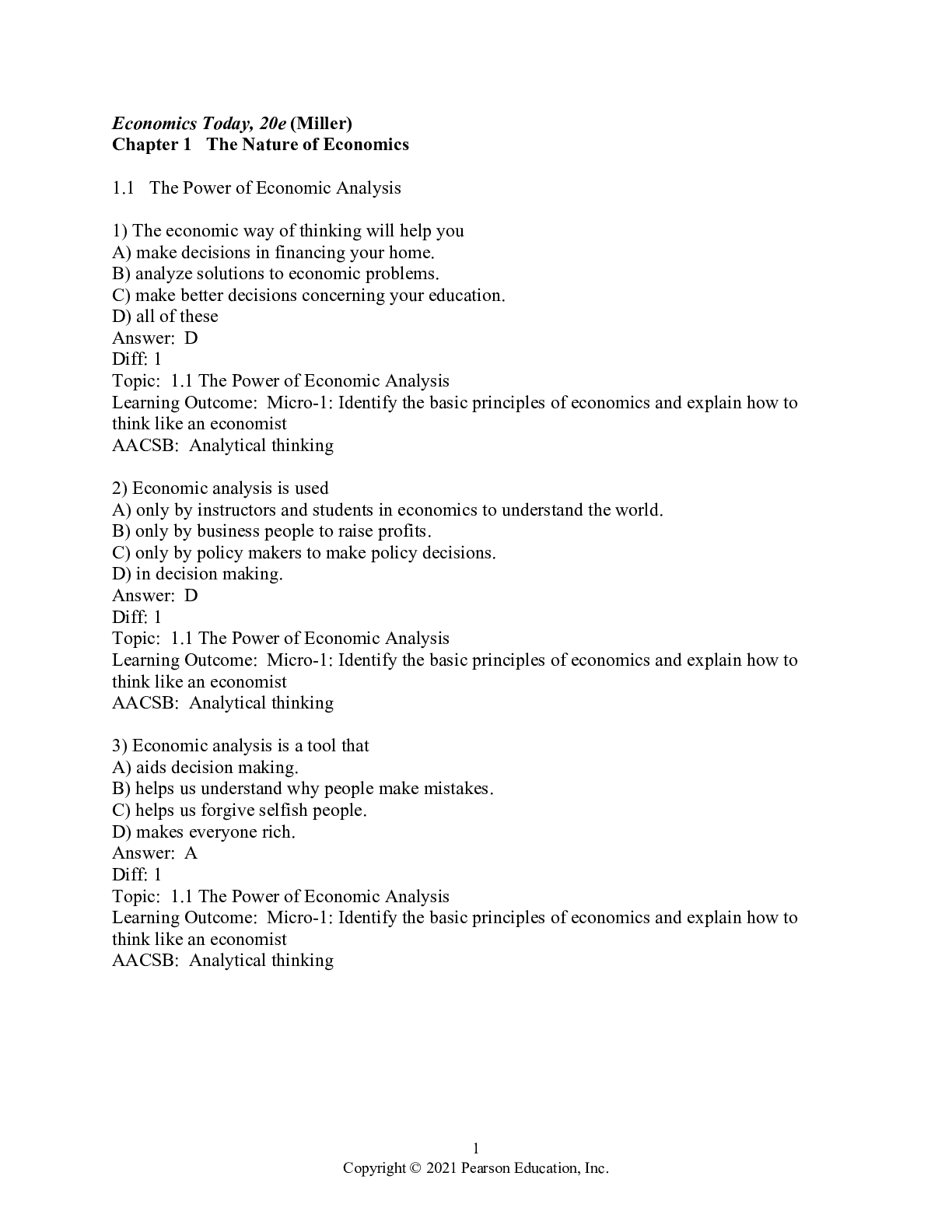
Buy this document to get the full access instantly
Instant Download Access after purchase
Add to cartInstant download
Reviews( 0 )
Document information
Connected school, study & course
About the document
Uploaded On
Sep 02, 2022
Number of pages
3605
Written in
Additional information
This document has been written for:
Uploaded
Sep 02, 2022
Downloads
0
Views
66

